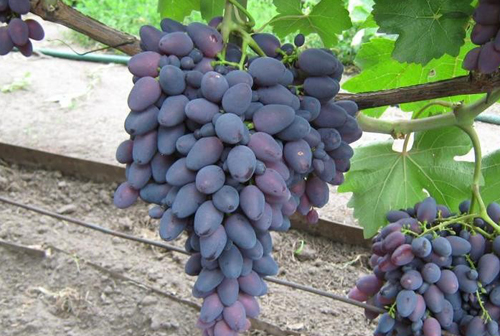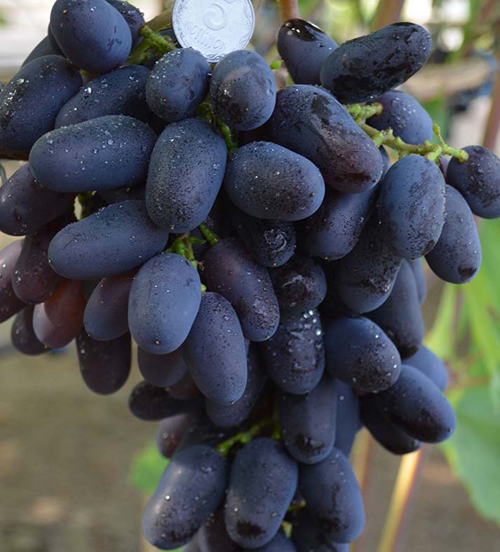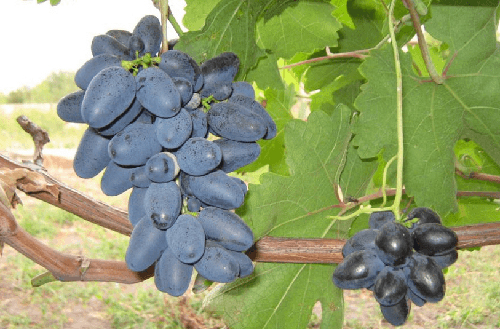Atos grape variety
Athos is a wonderful super-early hybrid form of dark-colored table grapes, bred at the end of the 2000s by an amateur Ukrainian breeder from the village. Estuary of Starobelskiy district of Luhansk region - Valery Bondarchuk. For many years, the researcher was friends with the famous scientist-winemaker Ivan Kostrikin from the All-Russian Research Institute of Viticulture and Winemaking named after V.I. ME AND. Potapenko, thanks to whose advice and methodological assistance he became interested in folk selection. On account of Valery Konstantinovich there are not so many famous achievements as his other colleagues in the craft, however, even those that exist have excellent characteristics, for which they are loved by many fans.

A striking confirmation of this is Athos, obtained from crossing the most popular variety in amateur breeding Mascot with a well-known Moldovan variety - Codryanka... The result of this hybridization was amazing. The new form not only inherited from the parents excellent gastronomic and aesthetic qualities of fruits, high yield and increased resistance to fungal diseases, but also turned out to be very early ripening, which is especially appreciated in modern table viticulture.
Today, our hero is very widespread throughout the post-Soviet space and is rightfully considered one of the best varieties of grapes in its class.
Agrobiological characteristics
The vigor of the bushes is above average. The crown of a young shoot is open, whitish from intense tomentose pubescence; reddish spots appear on young leaves. A fully developed typical leaf is large, rounded, mostly five-lobed, with a moderate degree of dissection. The surface of the leaf blade of the variety is smooth, dark green with light veins. Top side cutouts of medium depth, closed, no clearance. The lower notches are small - slit-like, V-shaped, or barely outlined. Sometimes they may be completely absent. The petiolate notch is often closed with a transverse oval lumen and a pointed bottom, but there are also open lyre-shaped ones. Petioles are rather long, greenish-red. The teeth along the edge of the leaf are large, triangular, with strongly convex sides and pointed apices. The flowers are bisexual, which allows them to pollinate well in almost any weather, without subsequently showing pea berries or excessive loosening of the bunches. Scattering of buds and ovaries in grapes was also not noticed. The vine ripens 100% of its length annually, turning brown, with nodes several shades darker than the internodes.

The bunches of Athos reach large sizes, while having a conical shape and a structure of moderate density. The average mass of brushes ranges from 500-700 grams, but specimens weighing more than a kilogram are by no means uncommon. The ridges are not too long, light green, grassy, strong enough. The grapes are very attractive in appearance, large, elongated ovoid, dark blue, covered with a thick layer of gray pruin bloom. Their average weight is 10-12 grams. The grapes in the brush are well calibrated, and due to their not too dense arrangement, they do not deform against each other and do not get damaged. The pulp of this variety is quite dense, fleshy-juicy, crunchy, with a pleasant balanced taste and a simple varietal aroma. The aftertaste of fully ripe berries reveals soft floral nuances. Sugar accumulation at the time of ripening is quite high - 18-19 g / 100 ml, and this figure continues to grow during the ripening of the bunches on the vine. There are no clear data on titratable acidity, but the taste does not even feel a hint of excessive acidity. The skin of the grapes is medium in thickness and strength; when eaten, it is chewed without any problems.The seeds are available, but they do not have a negative impact on the gastronomic properties. The general tasting score of Athos is always on top.
The main use of the harvested crop is fresh consumption. Large-fruited, sweet and tasty grapes are not ashamed to be brought to the market, where buyers appreciate the variety and do not allow it to lie on the counter. For commercial cultivation, an especially important advantage is the early maturity of the variety, allowing it to start trading in times of little competition and high grape prices. But this is not the only reason why our hero is valuable to farmers. His transportability is also excellent, which allows transporting crops over long distances without spoilage and loss of presentation, as well as keeping quality, thanks to which the collected clusters do not lose their freshness for a long time, especially when creating an optimal indoor climate. Our hero is very much appreciated by amateurs for unpretentiousness, ease of care, and decent yield at the same time. In addition to consumption directly for food, in private households it is widely used in canning, where it also shows itself only from its best side.

The variety ripens very early - in its homeland, in the Luhansk region, harvesting can begin in early August, and in more southern regions even at the end of July. The growing season from bud break to the onset of removable ripeness is only 95-100 days, and according to this indicator, the variety is deservedly ranked among the super-early group. The sum of active temperatures, which corresponds to a similar ripening period, is only 2100-2200 ° C. With such indicators, the broadest prospects for moving to the north are open before Athos, where the cultivation of grapes seemed fantastic until recently. The experience of many winegrowers shows the possibility of obtaining a high-quality harvest of this hybrid even in the conditions of the Moscow region and other regions located at a similar latitude. In this case, certain troubles will be caused only by the low frost resistance of the form (-22 ... -23 ° С), however, careful covering of the vine for the winter at once removes this problem.
The yield of the variety, albeit not phenomenal, is stable over the years, and in general more than decent. About 130 centners of fruit are obtained from a hectare of industrial plantings, and in individual plantings, each well-developed bush, which is fully cared for, is capable of producing up to 15, and often more, a kilogram of grapes. Athos responds well to moderate watering and fertilizing with mineral fertilizers. It “pulls out” the standard load without any problems, however, due to the increased fertility rate and the large size of the bunches, it needs annual yields rationing. Overly loaded bushes begin to lag behind in growth, fruits shrink on them, the maturation of the vine and harvest lengthens, the taste of berries deteriorates. If you ignore these signals and repeat the negative experience every year, then soon the plants will weaken to such an extent that they can simply die in winter. Therefore, it is especially important to avoid such omissions in regions with short summers and harsh climatic conditions.
A ripe crop can continue to hang on the bushes for a very long time - up to a month. There is no withering of berries due to loss of moisture, just as it is not noticed for the variety of cracking of grapes even in rainy weather. This allows you not to worry about the presentation of the ripening bunches, which during this time only become sweeter. In addition, thanks to its strong skin, this grape is not damaged by wasps or other insects, which makes its protection quite simple compared to other varieties.
Agrotechnical features
Considering the above, Athos can be described as a very unassuming hybrid, capable of growing and producing good yields even among inexperienced winegrowers. It is also impossible not to note its excellent plasticity. In particular, its cultivation is possible on a wide variety of soil types and in various climatic conditions, differing in the level of heat and moisture supply. Only too acidic or saline soils, damp and swampy areas, places with a high level of groundwater are not suitable for the hybrid. When landing on slopes, be sure to pay attention to their exposure. Plains are also perfect for our hero, however, in the northernmost areas of growth, it is advisable to provide protection from cold winds by planting grape bushes from the sunny side of various buildings located on a personal plot, in the so-called "wall" culture.
In areas free from root phylloxera, the variety propagates without problems by cuttings due to their ease of rooting. In addition to its simplicity, this method also has the advantage that the bushes planted in this way grow quickly and begin to bear fruit literally in the second year. However, in the presence of root aphids in the soil, this breeding option is undesirable, because self-rooted plants can die within a few years after planting. In this case, seedlings grafted on phylloxera-resistant rootstocks are used, which, with all their disadvantages, are guaranteed to resist the malicious pest. The food area allocated for each bush should be at least 4-5 square meters. meters of land. With insufficient soil fertility, pits during planting are abundantly filled with organic and mineral fertilizers to ensure the active development of young plants.
Starting from the second, and sometimes already in the first year of life, the grape bushes begin to form in accordance with the plans for the covering or non-covering vineyard management. It should be recalled here that the frost resistance of Athos will be sufficient for cultivation without insulation on a high stem only in the mildest regions of our country in terms of climatic conditions - for example, on the Black Sea coast of the Caucasus. In other localities, it is widely practiced to shelter the variety for the winter, in connection with which the plants are given stampless forms according to the principle of an inclined cordon or a multi-arm fan.
To exclude crop overloads, fruiting bushes are cut into 30-35 eyes, shortening the fruit arrows to 6-8 buds. After the beginning of the growing season, the grapes produce fragments of sterile and weak shoots. Then, on fertile vines, excess inflorescences are removed while maintaining one brush per shoot. Only in this form can the rationing of the load be considered complete.
Defending against pests and diseases does not promise to be tedious, since Athos itself has good resistance to them. Therefore, chemical treatments can be limited to two or three early preventive sprays, and thus rely on an environmentally friendly crop.








